There’s much to plan in construction. While the building gets the attention, there are equally important functions happening outside of the final product. For example, the construction site. This is where all the work takes place, and that work can be dangerous. The building site requires site inspection, construction site safety and more.
Let’s take a closer look at this often-neglected side of construction project management. We’ll define what a construction site is, what is meant by construction site planning and inspection and explore the variety of construction sites and roles you’ll find when working in construction. Construction sites might not get the glory, but no construction project would be done without them.
What Is a Construction Site?
First, let’s define a construction site; it’s a piece of land on which a building or some other structure will be erected. It’s often referred to as a building site, but a construction site is typically more expensive. Construction sites are suitable for any type of construction.
But a construction site requires more than just setting up work on a plot. There are soil and vegetation that need to be addressed to make the site suitable. It’s only after this landscaping is complete and handed to the contractor to start work that it becomes officially a construction site.
There can be major or minor site changes depending on the condition of the plot. However, all construction sites must comply with the local building regulations that govern when and how work can be done.
ProjectManager is robust project management software with multiple tools and features for planning, scheduling and tracking construction projects and construction sites. You can use tools such as Gantt charts, kanban boards, real-time dashboards and timesheets to create construction schedules, assign work to your team members, monitor resource utilization, track costs and much more. Get started for free today.
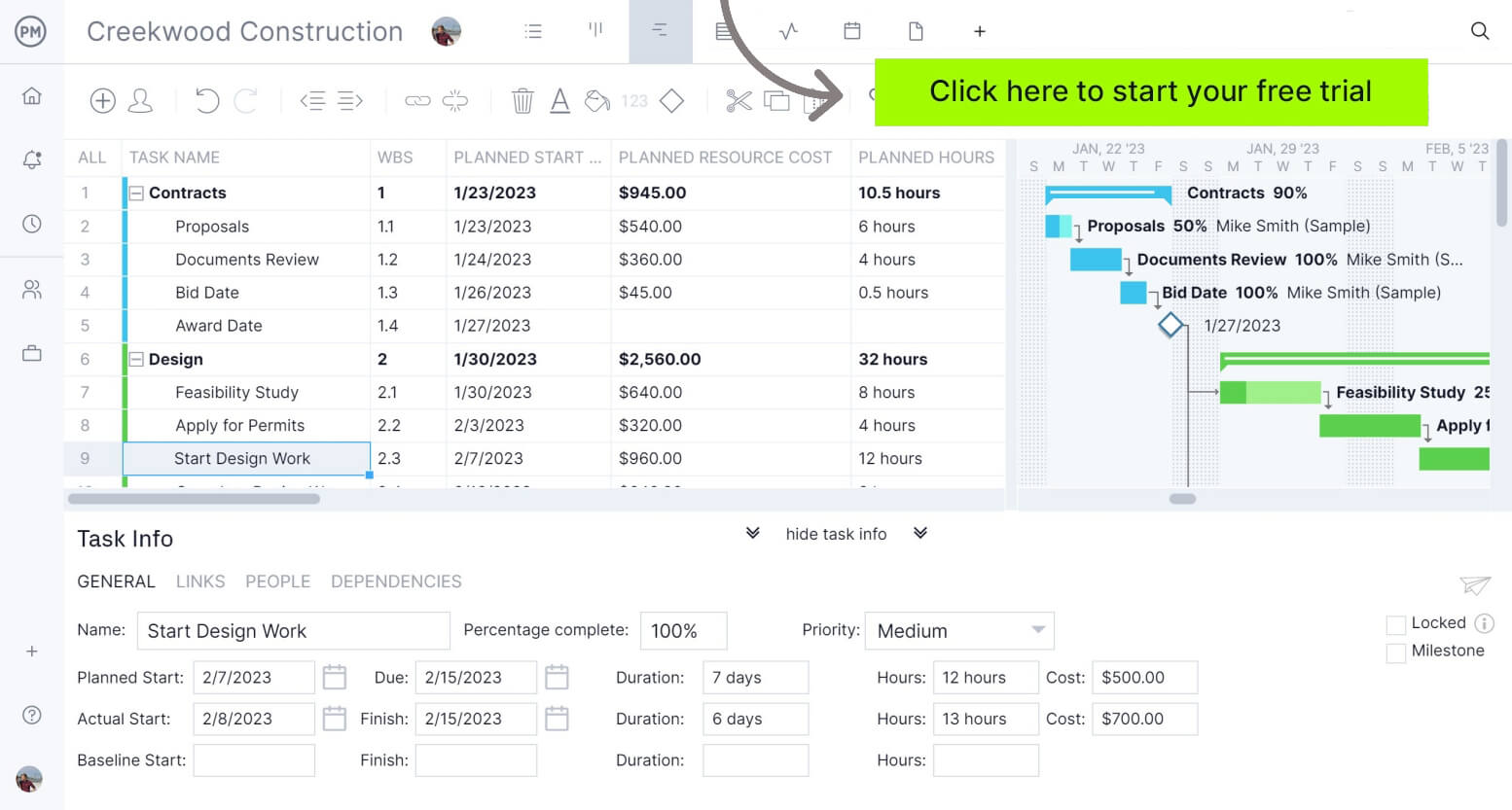
Types of Construction Sites
We mentioned two types of construction sites, commercial and residential. There are also industrial and infrastructure ones. Of course, there are other ways to define a construction site, such as by sector, owner, occupancy, etc. But there are four main types of construction sites that we’ll define.
- Residential construction sites: This is a construction that serves as a home for people, whether it’s single or multi-family homes, such as apartment buildings or row houses.
- Commercial construction sites: The commercial construction site is a place to erect structures related to business including offices, warehouses, etc.
- Industrial construction sites: Like commercial, industrial construction sites are places of business, but they’re factories and large-scale facilities that need more than office space. They manufacture products and include heavy machinery.
- Infrastructure construction sites: The last of our four main construction site types is infrastructure, which can be anything from roads and bridges to airports.
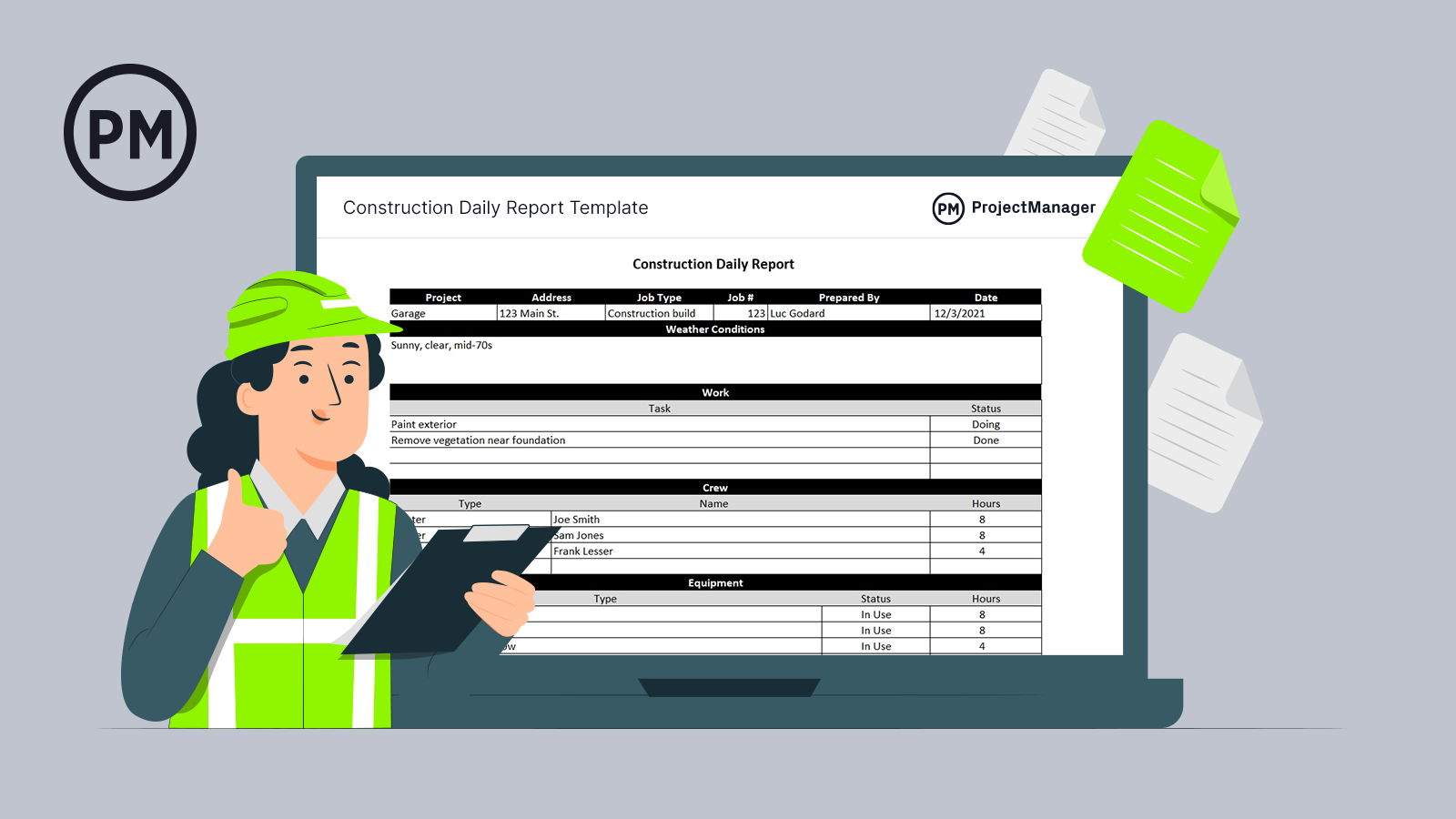
Get your free
Construction Daily Report Template
Use this free Construction Daily Report Template for Excel to manage your projects better.
What Is Construction Site Management?
The term construction site management refers to the process of analyzing the unique conditions of a construction site, preparing it, managing the daily activities of the construction crew and ensuring there are sufficient resources such as labor, materials and equipment when they’re needed.
There are lots of different construction site management activities, which can be divided into key areas such as:
- Construction site analysis
- Construction site planning
- Construction site inspection
- Construction site monitoring
- Construction site safety management
What Is Construction Site Planning?
A professional who’s either a licensed engineer, architect or land surveyor executes site planning. The site plan also includes site analysis and planning to expand from the structures being erected to include transportation and other areas that’ll be affected by the build.
Sitting planning, especially site analysis, is the first step toward creating a construction project plan. You can’t build until you know what you’re building on and how to modify it to support the planned structure. Project management software helps you take this data and organize it.
ProjectManager is award-winning software that offers project management features for construction. For example, its Gantt chart view helps you create construction schedules, allocate resources, track costs and find the critical path of your project. You can also set a project baseline to compare your planned effort against your actual effort to keep to your construction plan and deliver on time and within budget.
In addition to Gantt charts, you can also use multiple construction project management tools such as kanban boards, project dashboards, reports and more. Get started with this free construction schedule template.
What Is a Construction Site Inspection?
A construction site inspection ensures the work being done complies with the plans and construction specifications of the project, but also the requirements of the client and code regulations. This isn’t a one-time event, but the job site is checked regularly throughout project execution.
There are more reasons for the construction site inspection, such as ensuring the quality of the work and the safety of its execution in terms of both the process and the finished product. This is part of the monitoring and reporting phase in construction and involves clear communication with stakeholders who have a vested interest in keeping the project expectations progressing as planned.
Construction Site Inspection Checklist
Construction site inspections cover a lot of ground, all of it critical to the success of the project. Here are some focus areas in a typical construction site inspection and why they’re so important to project success.
Daily Progress
A progress inspection is part of the daily responsibility on the job site to ensure that it complies with project requirements. These can be done by one or more project members depending on the size of the job. These individuals can also be from different trades as long as they’re experts in what they’re inspecting. If needed, experts can be brought in for inspections on outside issues, such as waste management or environmental policy.
Construction Site Safety Hazards
A construction site safety hazards inspection looks for on-site hazards, whether they’re a danger to the construction crew or to the integrity of what’s being built on the site. Not only are these hazards identified, but there are recommendations made to fix them, provide some kind of protection or mitigate the issue.
Regulatory Compliance
A regulatory inspection is part of the safety, performance and quality inspection for a job site. A safety inspector or regulatory inspector looks at the project’s operation and activities to ensure that the laws, regulations and rules are being followed.
Quality Control
This inspection is about overseeing the processes and procedures related to managing control on the construction site and making sure that the project and materials used are all meeting the standards set during the project planning phase. This is done to ensure that the expectations of all parties involved are being met.
Environmental Factors
An environmental factors inspection surveys and samples soil and existing structures on the construction site to measure asbestos and other environmental impacts. This includes groundwater sampling and phase I and phase II site assessments, which are done by qualified environmental professionals.
Draw Inspections
Of all the inspections listed for the construction site, the draw inspection is the simplest. It takes place in both commercial and residential construction projects and involves the builder and the lender. The draw inspection ensures the lender knows that the project is progressing as planned.

What Is Construction Site Monitoring?
Construction site monitoring is the process of tracking the activities that take place on the construction site and resolving issues that might occur to keep projects on track.
For example, one key activity of construction site monitoring is to manage project risks. Construction site managers must identify any potential risks that might bring the construction site to a halt such as machine breakdown, material shortages, lack of financial resources, accidents and even criminal acts such as theft.
Construction site monitoring also involves tracking other aspects of your project, such as reporting on the construction team’s daily activities to make sure they’re completing the tasks outlined in the construction schedule on time. Other examples include monitoring resource utilization to make sure your team isn’t exceeding the project budget or establishing a maintenance schedule for keeping construction site equipment in optimal condition.
Construction Site Safety Management
One unique characteristic of a construction site is that there will always be a variety of construction site hazards that might affect the safety of construction workers. This always needs to be accounted for when planning a construction project.
Construction site safety planning starts by identifying any project safety hazards and then establishing guidelines, rules and procedures to mitigate their potential impact. Then you should follow up with periodic construction site inspections to make sure site safety measures are implemented effectively.
Construction site safety management is an ongoing effort. It’s important to allocate financial resources for the procurement of protective equipment or implement any site safety measures during the construction execution phase.
Construction Site Management Documents
The construction site management process involves creating a variety of documents and reports that can help you plan, inspect, and monitor your construction site. Here are some of the most important construction site management documents.
Construction Site Plan
A site plan, also called a plot plan, is a drawing made by the architect, urban planner or engineer that illustrates the existing and proposed conditions for the construction site. These conditions can include buildings, roads, sidewalks, parking, drainage, sewer and water lines, lighting and landscaping.
A site plan is a drawing that illustrates the arrangement of whatever structures are to be built on the site, such as buildings, parking, drives and landscaping. The contractor uses several construction drawings to guide their work. But these drawings are also submitted to the local building authority to ensure they’re meeting the codes in the jurisdiction. Copies of the drawings are kept for historical records.
This is an important document that’s known by different names including site development plan, site layout plan, site plan drawing or plot plan. However, there’s a slight difference between site plans and plot plans. A plot plan shows the layout of a construction site only, while the site plan also includes its surroundings.
Site Inspection Report
A construction site inspection report is a document that’s created after a site inspection takes place and allows site inspectors to log all the different issues and observations they might have about a construction site.
This report should cover various aspects of a construction site such as site safety measures, compliance with building codes and other government regulations, condition of the equipment and machinery and quality of materials, among other things.
Daily Construction Report
A daily construction report is a document that allows the construction project management team to keep track of the construction site. A construction daily report allows you to log all the project tasks that are executed in a day, track the work hours of the construction crew, document resource utilization and other important details to keep track of the events.
We have created a free daily construction report template that can help you monitor the activities that take place in your construction site.
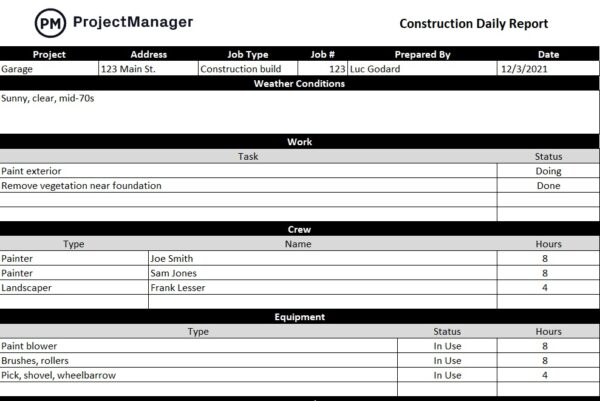
What Is a Construction Site Office?
A construction site office is a physical place within a construction site where management activities and meetings take place and documentation is stored. Besides the construction management team and site documents, one of the most important elements of a construction site office is construction project management software.
Construction site offices use construction project management software like ProjectManager to schedule the daily activities, balance the workload of construction crews, monitor resource utilization and track costs.
The roles and responsibilities of a construction site office might vary from one construction firm to another, but usually, there should be a construction site manager, a construction site supervisor and a construction site engineer. Let’s review these key construction site management roles.
Construction Site Roles
The construction site requires a vast number of construction workers to build the proposed structure. We’ve broken down the construction site roles involved in construction project management into four main disciplines.
Construction Site Manager
The construction site manager is usually the head of the construction site office. This role is responsible for allocating resources, controlling costs and other aspects of the construction site operations to help ensure construction projects are completed on time and within budget. They work with architects, surveyors and builders to keep the construction project on track and ensure that there are resources available when needed.
Construction Site Supervisor
While site managers are responsible for the bigger picture of a construction site, site supervisors have a lower degree of authority and focus on everyday activities. Some responsibilities of a site supervisor may include creating daily construction reports, managing site documentation, balancing the workload of the construction crew or tracking the work hours and performance of construction workers.
Construction Site Engineer
The construction site engineer offers technical advice as well as planning, marking out and leveling the construction site. This is done before any building takes place. They can also build roads, drainage systems and other related things. Their responsibilities are similar to that of a construction site manager as they both manage the project, supervise staff and offer onsite support.
Construction Site Inspector
The construction site inspector is responsible for reviewing the work on the construction site to make sure it passes all inspections, such as safety, code, etc. They not only check but record the results and manage that archive, which includes the time of the inspection and the materials reviewed.
Construction Workers
This leaves the construction workers, also called construction laborers or the construction crew. They execute the onsite tasks from removing debris to building scaffolding, loading and unloading building materials and operating heavy equipment.
ProjectManager Helps You Manage Your Construction Site
Managing a construction site involves a lot of work and coordination. ProjectManager is award-winning construction project management software that helps you plan, manage and track that work in real time.
There are a lot of different types of workers on a construction site and our software allows them to use whichever tool best suits their work. Construction site managers often prefer Gantt charts to plan, schedule and monitor work, while construction workers find kanban boards and task lists more beneficial. All of our project views update in real time so no matter which tool you choose, you’re working on the most current data.
Manage Construction Bids With Kanban Boards
ProjectManager’s kanban boards allow construction firms, project owners, general contractors and subcontractors to manage their construction bids with one tool. Create kanban board columns to group your construction bids by their status such as sent, in review and approved or rejected. This allows you to track your construction bids, communicate with your team online and attach files with unlimited file storage.
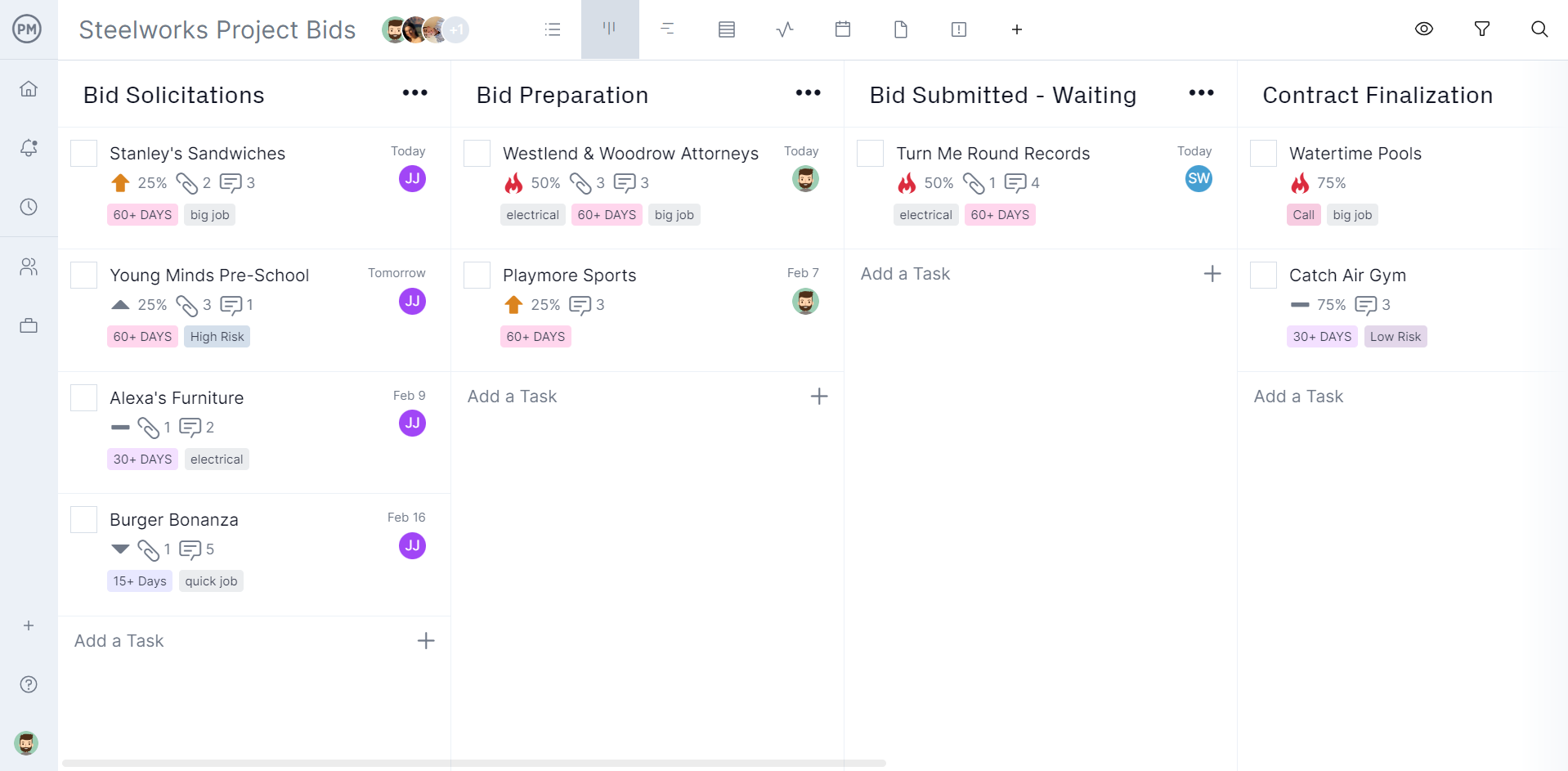
Get a High-Level View With Real-Time Dashboards
Construction site managers need to track progress, quality and more. Our real-time dashboard gives them a high-level view of the project whether they’re onsite, in the office or anywhere. It automatically collects project data and displays it in easy-to-read graphs and charts that show metrics such as time, cost, workload and more. Unlike lightweight tools, there’s no time-consuming configuration required. All you have to do is toggle over to the dashboard and it’s already calculated and displayed.
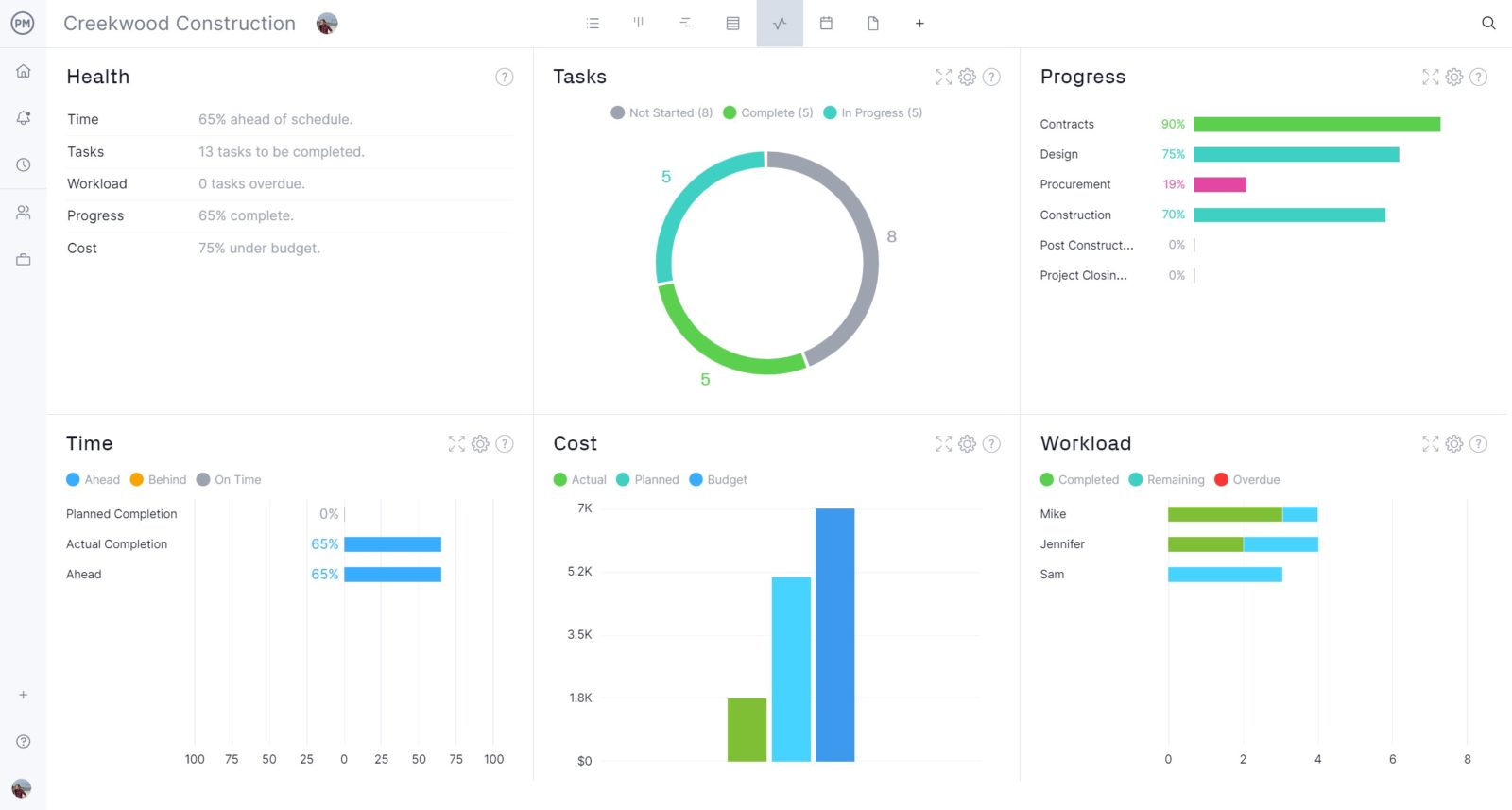
Log Hours Anywhere With Secure Timesheets
The last thing construction workers want to do after a day laboring on the construction site is rush back to the office to log their hours. Our mobile app makes filing timesheets easy no matter where you are. Once submitted, the timesheet is locked and delivered to a supervisor who reviews and submits them. Timesheets are also a great tool to track the percentage of crew members’ work that has been completed. You can view how much of their tasks are done and get a better idea if you’re on schedule.
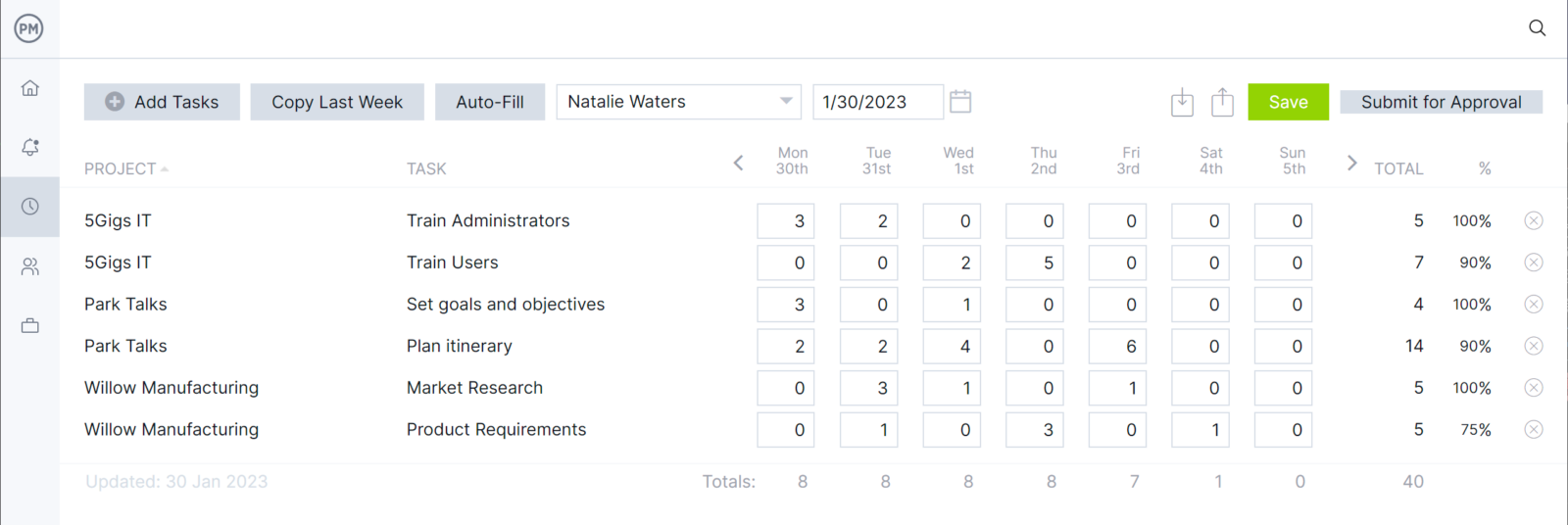
Those are only a few features available on our robust software. You can use risk management, task management and resource management features, too, plus customizable reports that offer more detail than dashboards and can be shared with stakeholders. If you’re managing a construction site and a construction project, then you want to have these features in hand on our mobile app or anywhere you can connect to the internet.
ProjectManager is online construction project management software that empowers teams to plan, manage and track their work in real time. Our collaborative platform means that you’re connected anywhere and at any time to share files, comments and more. Get started with ProjectManager today for free.

